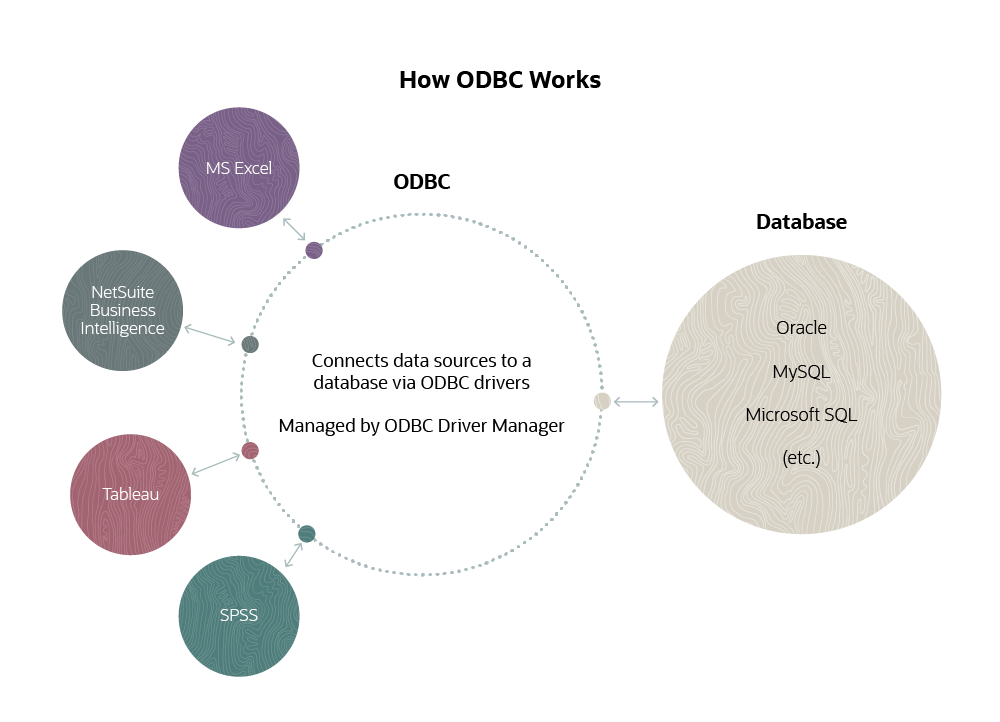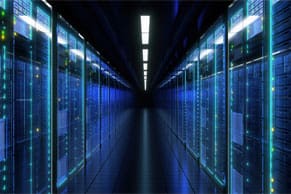Most organizations use applications that access information in relational databases. Open Database Connectivity (ODBC) is a standard that lets any application work with any database, as long as both the application and database support the standard. You can think of ODBC as a universal translator between applications and data stores. ODBC can be especially useful if your applications and database come from different vendors. It's also extremely important for business intelligence (BI) dashboards and other analytical applications that pull information from multiple data sources.
What Is ODBC (Open Database Connectivity)?
ODBC is an application programming interface (API) that provides a standard way for applications to access information in relational databases and other data stores. Applications that use the ODBC API can access data in any ODBC-compliant database, generally without requiring changes to the application code. Furthermore, applications can access information in multiple databases at the same time, which is a boon for companies that operate a collection of database products.
Key Takeaways
- ODBC is an industry-standard API that allows compliant applications to access any data store with an ODBC driver.
- ODBC is particularly useful for companies that have applications and databases from different suppliers.
- ODBC is also valuable for business intelligence and other analytical applications because it makes it easier to combine data from multiple sources.
ODBC Explained
ODBC, which stands for open database connectivity, has become a widely accepted standard because it allows application developers to create a single version of an application that can access information in multiple relational and nonrelational data sources from different suppliers. Many business applications, including analytical and desktop productivity tools, use the ODBC API to access information in ODBC-compliant data stores, such as relational databases. The ODBC API defines a standard version of the SQL database language, as well as other functions needed for communication between an application and a database. Virtually all major relational database suppliers support ODBC, as well as leading ERP suites and a wide variety of other software products.
This near-universal exchange of data through a single interface can save companies considerable time and money by eliminating the need to adapt applications to work with different databases. An additional advantage of ODBC is that it can access information in multiple databases at once. This has powerful implications for creating analytical tools, such as business intelligence (BI) dashboards that may draw on many data sources. Using ODBC, applications can directly combine information from all of these sources. For example, an application could combine information from desktop spreadsheet applications with financial data managed in an Oracle or MySQL database. This not only simplifies dashboard creation but also makes data management and storage more efficient.
History of ODBC
The history of ODBC dates to 1989, when a group of software companies formed the SQL Access Group to define standards for database interoperability. By then, SQL had emerged as a widely used language for relational database access. Accordingly, application developers embedded SQL calls in their programs in order to retrieve and update information in databases, but a key problem was that the SQL versions provided by different database suppliers varied widely. To solve this problem, the industry group started defining a standard Call Level Interface (CLI) that could be used to access any database. This interface was ultimately incorporated into the International Organization for Standardization's SQL standard in 1995.
Microsoft developed ODBC based on this interface work, introducing the first implementation in 1992. Many other companies have since built support for ODBC into their products, across multiple programming languages and operating systems. As a result, ODBC has become a standard method for accessing information not only in relational databases but also in many nonrelational data sources.
How Does ODBC Work?
A system using ODBC includes four main elements:
- Applications: Each application includes ODBC API function calls to retrieve, update or manipulate data in data sources.
- Driver manager: The driver manager manages communications between applications and data sources. It loads the ODBC driver for each data source and passes API calls from applications to the drivers.
- Drivers: Each database or other data source requires an ODBC driver. The driver translates ODBC API calls into commands that the database understands and returns data from the database to the application.
- Data sources: The data source may be a relational database or a nonrelational store, as long as it has an ODBC driver. The data source may be on the same system as the application, on a different system within the company's network or in the cloud.

JDBC vs. ODBC
Java Database Connectivity (JDBC) is a database connectivity API that is analogous to ODBC but works only with applications written in the Java programming language. Java and JDBC were originally developed by Sun Microsystems, which was later acquired by Oracle Corp.
As with ODBC, each data source requires a driver. A large and growing number of software companies have built or are building JDBC-based applications and data sources. In addition, some companies provide bridging software that connects JDBC applications to ODBC databases.
Misconceptions About ODBC
Despite the fact that ODBC has been widely used for many years, several misconceptions about the technology still exist. Here are some of the most common myths — and their realities.
Myth: ODBC is a significant security risk.
Reality: Human error and poor data management can create security problems
with any application or database. However, users must have valid credentials to use any
applications that access data via ODBC. Many databases also include strong controls that
further safeguard data, and some solutions allow you to configure read-only access to data
via ODBC.
Myth: ODBC doesn't support my operating system or programming
language.
Reality: ODBC support has expanded far beyond the original Microsoft
Windows implementations. Today, ODBC is a standard for data access across different
operating systems and programming languages, for both on-premises and cloud-based
environments. Microsoft's own ODBC for its SQL Server database is available on Linux.
Myth: ODBC is obsolete.
Reality: ODBC remains in widespread use today and will continue to be
valuable in the future. However, some web development platforms now include direct links to
common databases, such as MySQL, so applications don't need to use ODBC to connect to
those databases. On the other hand, ODBC is extremely important for dashboards and other
business intelligence applications because it makes it much easier to gather data from
different data sources for analysis. In recent years, there's been more focus on ODBC
than other proprietary drivers.
Conclusion
ODBC remains a lynchpin technology for enabling applications to access information in different data sources. It makes it easier for businesses to use information from a variety of different databases and online data sources. ODBC is extremely valuable for analyzing data from multiple sources to enable more informed decision-making, which can be a critical factor in business success.
ODBC FAQs
What is ODBC used for?
ODBC is widely used for enabling applications to access information in different data sources. It is a standard API that enables an application to access any database with an ODBC driver. It provides interoperability between applications and databases from different vendors.
Is ODBC outdated?
ODBC is not obsolete, but some web development platforms allow applications to access databases without using ODBC. ODBC has become particularly valuable in combining data streams from different sources for business intelligence applications.
What is the difference between ODBC and JDBC?
ODBC and JDBC are both APIs that enable applications to access different databases. However, JDBC is specifically designed for and limited to Java-based applications, while ODBC is supported by many different languages.
How does an ODBC connection work?
ODBC uses several cooperating elements. Each application uses standard ODBC API calls to access data. Each data source must have an ODBC driver that translates ODBC calls into functions that the database understands. A driver manager loads the drivers for each data source on behalf of applications and passes requests from applications to data sources.








